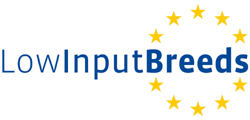Contact
Dr. Hichem Ben Salem
Institut National de la Recherche Agronomique de Tunisie
Rue Hedi Karray
Ariana 2049
Tunisia
Tel. +216 71 230024![]() E-mail
E-mail
Second LowInputBreeds Symposium

Feeding and management strategies to improve livestock productivity, welfare and product quality under climate change
= 14th International Seminar of the FAO-CIHEAM Network on Sheep and Goats Sub-Network on Nutrition and 2nd Symposium of the LowInputBreeds project
- Date: May 15 to 18, 2012
- Venue: Hammamet, Tunisia
- Organisation: National Institute of Agricultural Research of Tunisia (INRAT) and the Pasture and Livestock Agency (OEP-Tunisia) & Mediterranean Agronomic Institute of Zaragoza (CIHEAM-IAMZ)
- Key documents
 Second announcement (209 KB)
Second announcement (209 KB) Programme of May 18th, with the presentations about the progress of the LowInputBreeds project (155 KB)
Programme of May 18th, with the presentations about the progress of the LowInputBreeds project (155 KB)- Website www.iamz.ciheam.org/tunisia2012
 and www.lowinputbreeds.org/symposium-2012.html
and www.lowinputbreeds.org/symposium-2012.html 
National Agricultural Research Institute of Tunisia, Tunisia
 |
The National Agricultural Research Institute of Tunisia INRAT is a governmental scientific research institution depending on the Ministry of Agriculture and Water Resources. It is located in Tunis, and was founded in 1906. It is the first Tunisian institute specialized in agricultural research. Since 1961, research activities at INRAT cover all fields of agricultural science research; namely, animal and crop production, biophysical and socio-economic research. In the year 2000, and following the reorganization of the research system in Tunisia, INRAT has been reorganized into consolidated laboratories and research units. Regional research activities are carried out through 12 experimental stations.
INRAT’s main missions are the following:
- Improvement of techniques for animal and crop production;
- Evaluation and upgrading of genetic resources in Tunisia;
- Selection of crop varieties and improvement of animal breeds;
- Performing agro and socio-economic research in relation with the rural environment;
- Contribution to technology transfer and capacity building through teaching and supervising graduate and post graduate (Doctorate, Master of Science, etc.) students as well as training of students and technicians working in national and international organizations.
The Laboratory of Animal and Forage Production is involved with the current project 'LowInputBreeds'; it was created in 1963, and its mandate is:
- to contribute in the national effort focusing on the quantitative and qualitative improvement of animal and forage productivity (milk and meat);
- to conduct scientific and applied research in the field of livestock and feed resources, and to transfer technologies to potential users;
- to contribute to capacity building through teaching, supervising and training students and technicians.
The research program of this laboratory is composed of five main fields conceived within the framework of national priority programs:
- Topic 1. Quantitative and qualitative improvement of sheep and goat performances;
- Topic 2. Quantitative and qualitative improvement of bovine performances;
- Topic 3. Development and better use of forage and pastoral genetic resources;
- Topic 4. Management and use of pastoral resources;
- Topic 5. Better use of crop residues, agro-industrial by products and marine plants in livestock feeding.
In addition to facilities at the laboratory headquarters (analyses unit, experimental plots, etc.) four experimental stations are attached to this laboratory where most in vivo studies on stall-fed or grazing sheep and goats are conducted. Also, perennial forage and pastoral species are cropped. These stations are regularly visited by farmers, technicians and students.
The Laboratory has many publications in national and international journals, patents and subscribed selected forage varieties, etc. In addition, the Laboratory is and has been involved with numerous national and international research and research - development projects. Since 2001, it has been coordinating the FAO-CIHEAM Sub-Network on Sheep and Goat Nutrition.
Staff involved
- Dr. Hichem Ben Salem
 This website was archived on December 19, 2017 and is no longer updated.
This website was archived on December 19, 2017 and is no longer updated.


